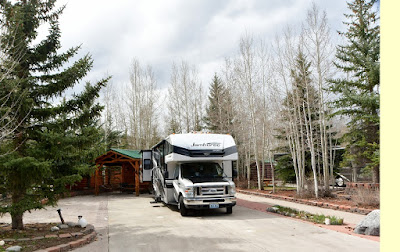Checking out this morning, I spoke once again to the super friendly Italian girl from Venezuela who was just thrilled to have had us as guests and wished me a safe journey and told me she hoped we'd return someday. That prompted me to ask her what months I should avoid in the future and she was quick to recommend that I avoid July and August as they are habitually booked for those two months well in advance.
If you're thinking of visiting the Tiger Run Resort, I would definitely recommed that you call in advance before showing up as we did. We were fortunate that we got a spot without a reservation. The town of Breckenridge, should you have transporation or arrange transporation into town, should keep you busy for however much time you have to spend.
We didn't drive that many miles today, but we decided to do laundry first thing this morning which held us up a bit. Plus, the route I set out for us was our usual two-lane ribbon of asphalt that was mostly up hill and down dale and twisty as a coiled rattlesnake. We were hoping for sunshinve today, and we got our wish at first. But it soon became apparent that our future probably held the strong possibility of rain before we reached our camp for the night.The route we chose continued to avoid the most heavily-populated regions in favor of places that no one bothered to go. For that reason we chose Route 40 out of Breckenridge as it went north toward Steamboat Springs and north was our favored direction of travel. Trouble was, you had to drive east on Interstate 70 for twenty-five miles to reach the junction with Route 40. Instead we decided to go west and jump on Route 131 north which also led to Stearmboat Springs. The distance traveled was negleable and it also afford us an opportunity to stop and gas up the rig.
We thought that Route 131 would be mostly vacant of traffic in either direction since it was well off the beaten path. What we didn't know was that Route 131 provided an easy access for those who wanted to do some river rafting on the Colorado River which crossed Route 131 ten or fifteen miles above the I70/Route 131 junction. In addition, there must be some fine fishing and off-road motorbiking in the area as we encountered more than few folks taking advantage of both those pursuits.
The going was slow as the grades were steep, both up and down. But what I liked was the wonderful visitas and the intriguing varieties of geologic formations that we passed. Most of the time we couldn't stop to photograph those formations, but there appeared to be a huge variety of including volcanic and sedimentary. At one point we stopped to collect rocks for our rock garden at home and Concetta managed to find what was obviously a metamorphic rock that is known to geologists as breccia.Breccia is what you get when bits and pieces of rock that weather out of larger formations, along with sand or mud, are buried deep enough (like miles down) to become super heated by pressure and begin to form an amalgum. Later, when this amalgum cools and weathers out at the surace you get a base rock with the appearance of having foreign bits of other rocks embedded (photo above right). This rock is neither volcanic nor sedimentary.
The other geologic oddity that we saw today as we motored north on Route 131, just west of 11,978 foot Trappers peak, was a whole "field" or valley full of volcanic plutons (photo left). A pluton is a sort of "dome" of magma formed underground. The dome rises or intrudes between other rocks and never reaches the surface to form a volcano. Since it cools below the surface, you never are aware of plutons unless the surrounding land erodes or weathers away sufficiently to expose the solid magma formation.
We could hardly believe our eyes as we encountered the first pluton on Route 131. Because of the nature of the highway, we were unable to stop and photograph the first one we saw. But soon we encounterd another, and then anther, until we had counted no less than five within a five-mile stretch. Fortunately, I was able to photograph a couple of these plutons for the blog.To illustrate a pluton that you might already know about, think about the Devil's Tower in Wyoming that you may have seen in "Close Encounters of the Third Kind." Closer to home, if you're a Nevada resident, I believe that Cave Rock at Lake Tahoe is a prime example of a Pluton.
The remainder of our day was pretty mundane as we rolled along without incident, did a bit of shopping at the Safeway in Steamboat Springs, then headed for KOA at the north end of town (photo right). Though I got a lecture for not making a reservation from the desk clerk, the camp is pretty nice overall. I tried to explain to the clerk that we seldom have any idea how far we'll drive in a day, but I don't think she was impresssed with my explanation.
Once we arrived at our campsite, I actually spent more time helping the two young campers next door with their sewer line problem than I spent getting our rig set up. But sometimes you just have to do what's right in the moment. And, though we were threatened with rain the whole time I worked outside, I never did get wet. In the end, all was well that ended well.


































